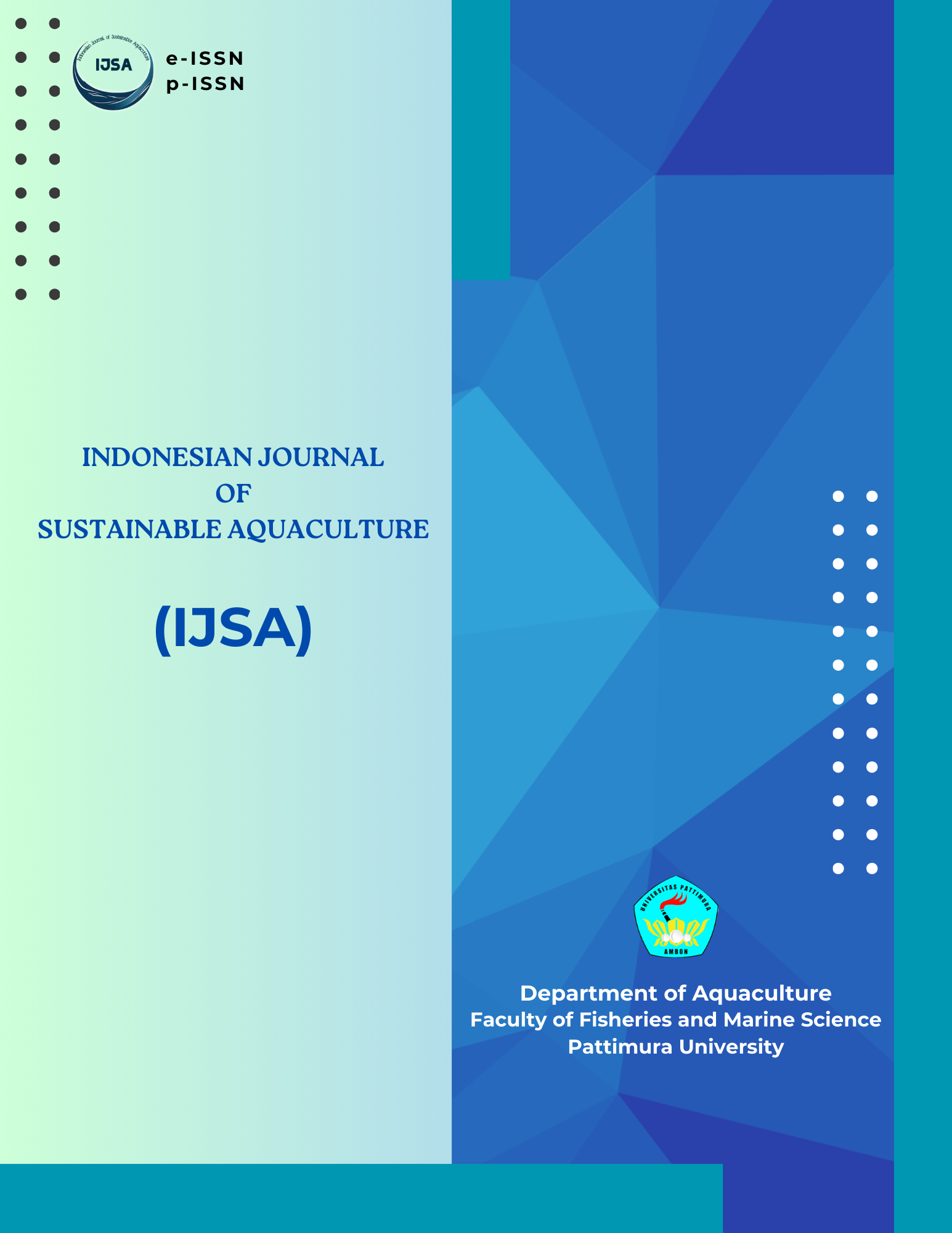Evaluasi Konsentrasi Hormon Progresteron Pada Lobster (Panulirus versicolor) Dengan Ukuran Berbeda Menggunakan Metode Enzyme-Linked Immunosorbent Assay (ELISA)
Evaluation of Progesterone Hormone Concentration of Lobster (Panulirus versicolor) with Different Sizes Using Enzyme-Linked Immunosorbent Assay (ELISA)
Abstract
Control of gonad maturation and spawning is a major problem in the development of shrimp and lobster cultivation. Reproductive technology in hatching this type of crustacean has not experienced significant development. Progesterone is a precursor of estrogen in vertebrates, which is also found in crustaceans and other invertebrates. While several crustacean reproductive hormones have been characterized, the identity and function of other reproductive hormones are still under investigation. In hormone analysis, the use of the Enzyme Linked Immunosorbent Assay (ELISA) method continues to grow, both for research purposes and clinical applications. This study aims to evaluate the concentration of the hormone progesterone in Panulirus versicolor lobsters of different sizes with a body weight range of 300-750g which are caught in the wild using the ELISA method. The hormone progesterone is measured in the ovaries, hepatopancreas and hemolymph. This research uses descriptive analysis methods. From using the ELISA method, the results of the parallelism test showed that the test sample curve was parallel to the standard curve. Absorbance and standard value recovery tests showed that the measured concentrations of the progesterone hormone in Panulirus versicolor lobsters were acceptable because they had an average recovery value of 98%. The precision testing results of the ELISA kit used show that the test prescription is good and acceptable based on the percentage of coefficient variation (%CV) from QC1 and QC 2 (<15%). The concentration value of the progesterone hormone in P. versicolor lobsters shows that there is a difference in concentration depending on body size, where in lobsters with a body weight of 650-750g, the concentration of the progesterone hormone in the hepatopancreas, ovaries and hemolin is 1.059 ng/ml, 0.357 ng/ml and 0.042 ng/ml. while at lower body weights, namely 300-350 grams, the concentration of the hormone progesterone is 0.753 ng/ml, 0.181 ng/ml, 0.010 ng/ml.
Downloads
References
Adiyodi, R. G. (1985). Reproduction and its control. The biology of Crustacea, 9, 147-215.
Bowen, R. A., Hortin, G. L., Csako, G., Otañez, O. H., & Remaley, A. T. (2010). Impact of blood collection devices on clinical chemistry assays. Clinical biochemistry, 43(1-2), 4-25.
Chang, E. S., & Sagi, A. (2008). Male reproductive hormones. In Reproductive biology of crustaceans (pp. 299-317). CRC Press.
Ederveen, J. (2010). A practical approach to biological assay validation. Hoofddorp: Progress, 106(1).
Fazielawanie, N. M. R., Siraj, S. S., Harmin, S. A., Ina-Salwany, M. Y., & Nik-Daud, N. S. (2011). Development and validation of enzyme-linked immunosorbent assay (ELISA) vitellogenin in Lates calcarifer. Journal of Fisheries and Aquatic Science, 6(7), 715-727.
Gholib, G., Wahyuni, S., Akmal, M., Hasan, M., Agil, M., & Purwantara, B. (2020). The validation of a commercial enzyme-linked immunosorbent assay and the effect of freeze-thaw cycles of serum on the stability of cortisol and testosterone concentrations in Aceh cattle. F1000Research, 8, 1220.
Huang, H., Ye, H., Han, S., & Wang, G. (2009). Profiles of gonadotropins and steroid hormone-like substances in the hemolymph of mud crab Scylla paramamosain during the reproduction cycle. Marine and Freshwater Behaviour and Physiology, 42(4), 297-305.
Kinn Rød, A. M., Harkestad, N., Jellestad, F. K., & Murison, R. (2017). Comparison of commercial ELISA assays for quantification of corticosterone in serum. Scientific reports, 7(1), 6748.
Lee, J. W. (2009). Method validation and application of protein biomarkers: basic similarities and differences from biotherapeutics. Bioanalysis, 1(8), 1461-1474.
Merlin, J., Mohanlal, D. L., Balasubramanian, C. P., Sherly, T., Subramoniam, T., Syamadayal, J., ... & Vijayan, K. K. (2015). Induction of vitellogenesis and reproductive maturation in tiger shrimp, Penaeus monodon by 17ß-estradiol and 17α-hydroxyprogesterone: in vivo and in vitro studies. Invertebrate Reproduction & Development, 59(3), 166-175.
Reddy, P. S., & Ramamurthi, R. (1999). Recent trends in crustacean endocrine research. PROCEEDINGS-INDIAN NATIONAL SCIENCE ACADEMY PART B, 65, 15-32.
Subramoniam, T. (2000). Crustacean ecdysteriods in reproduction and embryogenesis. Comparative Biochemistry and Physiology Part C: Pharmacology, Toxicology and Endocrinology, 125(2), 135-156.
Subramoniam, T. (2011). Mechanisms and control of vitellogenesis in crustaceans. Fisheries Science, 77, 1-21.
Swetha, C. H., Sainath, S. B., Reddy, P. R., & Reddy, P. S. (2011). Reproductive endocrinology of female crustaceans: perspective and prospective. Journal of Marine Science Research and Development S, 3, 1-13.
Tsukimura, B. (2001). Crustacean vitellogenesis: its role in oocyte development. American Zoologist, 41(3), 465-476.
Warrier, S. R., Tirumalai, R., & Subramoniam, T. (2001). Occurrence of vertebrate steroids, estradiol 17β and progesterone in the reproducing females of the mud crab Scylla serrata. Comparative Biochemistry and Physiology Part A: Molecular & Integrative Physiology, 130(2), 283-294.
Wilder, M. N., Subramoniam, T., & Aida, K. (2002). Yolk proteins of crustacea In: Raikhel AS, Sappington TW (Eds.) Reproductive Biology of Invertebrates. Vo l XII, Part A: Progress in Vitellogenesis. Science Publishers, Inc., Plymouth, UK. Pp: 131-173.
Copyright (c) 2025 The Author(s)

This work is licensed under a Creative Commons Attribution-NonCommercial-ShareAlike 4.0 International License.












